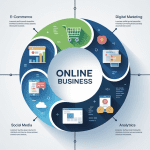
How to Scale Your Passive Income: A 4-Part Framework for Sustainable Growth
Building passive income streams is an exciting milestone on your journey to financial independence—but creating them is just the beginning.
To truly unlock their potential, you need to scale them strategically.
Scaling means expanding your reach, boosting your earnings, and reducing inefficiencies—while keeping things as hands-off as possible.
Scaling isn’t about doing more; it’s about doing better.
Whether you’re selling digital downloads, monetizing content, or investing in income-generating assets, the right systems can help you amplify your results without increasing your workload.
This four-part framework will guide you through scaling your passive income ventures in a smart, sustainable way. Let’s break it down.
1. Strengthen the Foundation Before You Scale
Before you grow any income stream, it’s essential to make sure it’s already working well. Scaling an inefficient or broken system only magnifies problems.
Begin by refining the foundation.
Key Areas to Audit and Improve:
a. Product or Service Quality
-
Whether you sell e-books, online courses, or print-on-demand products, your offering needs to deliver real value.
Example: If your course feels outdated, update the visuals, add bonus materials, or include recent insights. -
High-quality products lead to better reviews, more repeat customers, and organic referrals—all of which are critical for scalable success.
b. Automation and Workflow Systems
-
Automate repetitive tasks using smart tools. This includes fulfillment, customer emails, and even marketing.
Example: Use Zapier to connect your sales platform to your email list—ensuring new buyers automatically receive welcome messages or bonuses. -
Content creators can batch-schedule their work with tools like Buffer, Later, or Hootsuite to keep things running in the background.
c. Performance Tracking
-
Track what’s working and what’s not. Use tools like Google Analytics to monitor traffic, sales trends, and user behavior.
Example: If a particular product page has a high bounce rate, it may need clearer messaging or better visuals. -
For ads, monitor key metrics like click-through rate (CTR) and return on ad spend (ROAS) to ensure every dollar is well spent.
Action Step: Conduct a full review of your current system. Identify what can be improved, eliminated, or automated before attempting to grow.
2. Expand Your Audience and Visibility
Once your foundation is solid, the next step is increasing your reach. You can’t scale if no one knows you exist—so focus on attracting more eyes to your offer.
Strategies for Growing Your Reach:
a. Embrace Multiple Platforms
-
Avoid putting all your eggs in one basket. Expand where and how you show up online.
Example: If you sell digital planners on Etsy, try listing them on Gumroad, Shopify, or your own site.
Repurpose YouTube tutorials into Instagram Reels or blog posts to capture attention on other platforms.
b. Invest in Paid and Organic Marketing
-
Use targeted advertising on platforms like Facebook, Google, Pinterest, or LinkedIn to reach ideal buyers.
Example: Promote your freelancing course to digital nomads on Instagram or professionals on LinkedIn. -
Don’t ignore organic marketing. Search engine optimization (SEO) for blogs, YouTube, and Pinterest can drive free, long-term traffic.
c. Grow an Email List
-
An email list is one of your most powerful scaling tools. Build it by offering a freebie—like a checklist, guide, or resource—in exchange for sign-ups.
-
Use your list to promote new products, flash sales, or exclusive updates.
-
Tools like ConvertKit, Mailchimp, and ActiveCampaign let you automate welcome sequences and regular campaigns.
Action Step: Choose one new platform or marketing strategy to test this month. Experiment, analyze, and refine for best results.
3. Add and Diversify Income Streams
Scaling doesn’t always mean making one stream bigger—it can also mean adding new streams that complement what you already offer.
This creates stability and more earning potential.
Ways to Diversify Your Passive Income:
a. Offer Complementary Products or Services
-
Build on what already works by creating related offers.
Example: If you sell a productivity e-book, consider adding a digital planner, a workbook, or a coaching add-on.
If you run a blog, offer exclusive content or paid memberships.
b. Experiment with New Passive Models
-
If you’ve mastered one type of income, branch out into others.
Example: If your blog is performing well, try launching a YouTube channel or monetizing with affiliate links.
Already earning from dividend stocks? Consider REITs or low-maintenance Airbnb rentals.
c. Cross-Promote for Maximum Impact
-
Use one income stream to boost another.
Example: Mention your e-book at the end of a YouTube video, or bundle several digital products into a discounted package.
Action Step: Brainstorm one new product or model to add this quarter. Test its fit with your audience before going all in.
4. Grow with Partnerships and Smart Delegation
As your income grows, your time becomes more valuable.
Scaling smartly means getting help—from people, tools, and collaborators—so you can focus on high-impact tasks.
Growth Through Collaboration:
a. Partner with Influencers and Affiliates
-
Find others with audiences that align with yours and offer win-win collaborations.
Example: Let influencers promote your course in exchange for affiliate commissions.
Co-create bundles or giveaways with other creators in your niche. -
Explore joint ventures with businesses that offer complementary services.
Example: A nutritionist could team up with a fitness app to offer joint promotions.
b. Delegate Through Outsourcing
-
Hire freelancers or virtual assistants to handle the time-consuming stuff.
Examples: Customer service, email responses, graphic design, video editing, or social scheduling.-
Great platforms for this include Upwork, Fiverr, Freelancer, and Toptal.
-
c. Automate Everything You Can
-
Use smart software to minimize manual input.
Examples: Zapier for workflows, Printful for automatic fulfillment, Teachable for automated course delivery.
Action Step: Identify one area of your business to outsource or automate this month. Even small delegations free up space for growth planning.
Case Study: Putting It All Together
Let’s say you sell editable business templates online. Here’s how you could apply this framework:
-
Optimize the Foundation:
-
Upgrade your templates with better formatting and easy-to-use instructions.
-
Automate delivery using Etsy’s digital downloads or Gumroad’s instant access tools.
-
-
Amplify Reach:
-
Run Pinterest ads targeting small business owners.
-
Repurpose product demos into Instagram posts or short-form video tutorials.
-
-
Diversify:
-
Add a video tutorial showing how to customize the templates.
-
Create a “brand kit” bundle that includes logo templates and social post mockups.
-
-
Partner and Delegate:
-
Partner with a business coach to promote your templates to their email list.
-
Hire a virtual assistant to manage your store’s customer support and social media.
-
By applying this approach step-by-step, you can build a system that grows on its own—without burning out in the process.
Conclusion
Scaling your passive income ventures doesn’t require hustle—it requires systems.
By following this four-part framework—optimize, amplify, diversify, and delegate—you can grow sustainably and profitably.
The goal isn’t to do everything all at once. It’s to do the right things, consistently and efficiently, so your time and energy are multiplied—not drained.
Start with one step today. Because with the right strategy, your passive income doesn’t just grow—it scales itself.











